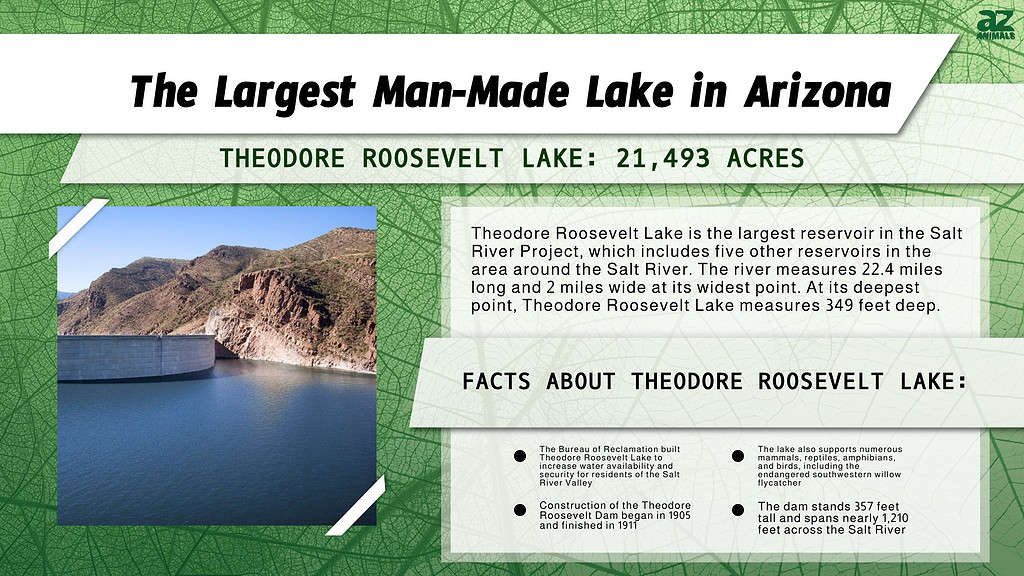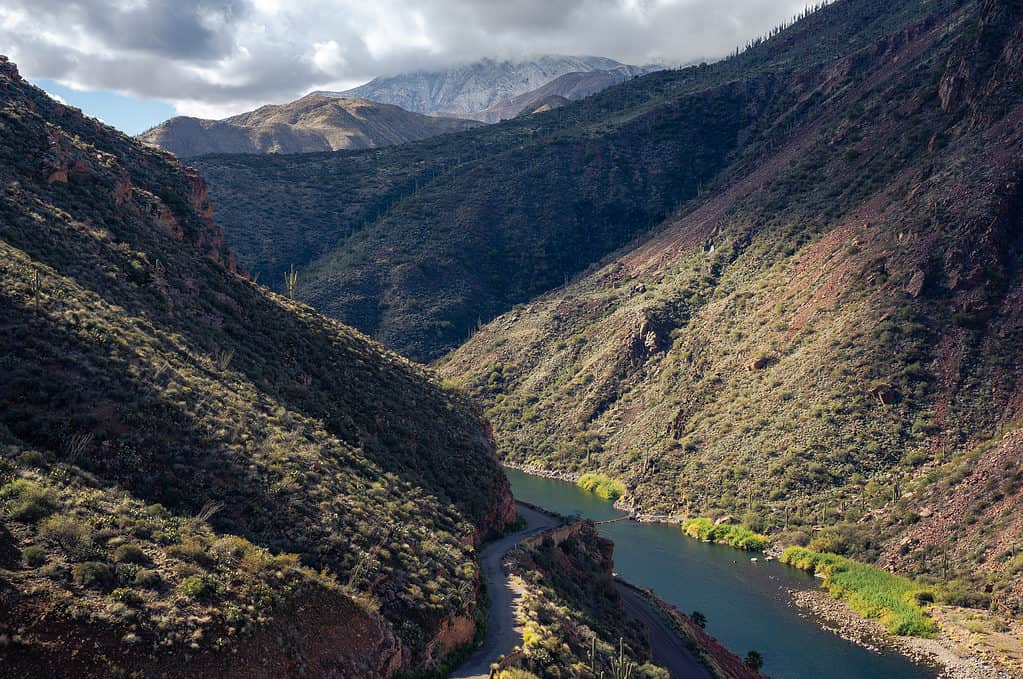Located 80 miles northeast of Phoenix, Theodore Roosevelt Lake is the largest man-made lake in Arizona. Also known as Roosevelt Lake or Lake Roosevelt, this freshwater reservoir also ranks as the largest lake located entirely within Arizona. This is because Lake Powell and Lake Mead extend over the border into Utah and Nevada, respectively. In total, the lake extends across a surface area of 21,493 acres. Originally, the Bureau of Reclamation constructed the reservoir to control flooding and water use along the Salt River. Today, the lake also provides excellent recreation and fishing opportunities.
Theodore Roosevelt Lake is the largest reservoir in the Salt River Project, which includes five other reservoirs in the area around the Salt River. The river measures 22.4 miles long and 2 miles wide at its widest point. At its deepest point, Theodore Roosevelt Lake measures 349 feet deep. Its total water storage capacity when it reaches its conservation limit equals 1,653,043 acre-feet. At this conservation limit, the lake sports 128 miles of shoreline. However, when in flood-control mode, the reservoir can hold up to 2,910,200 acre-feet of water, and its shoreline increases. That said, the U.S. Army Corps of Engineers systematically dumps any water above the conversation limit within 20 days.

The Bureau of Reclamation built Theodore Roosevelt Lake to increase water availability and security for residents of the Salt River Valley. However, the lake also ended up turning into a recreational hub in the region. Popular recreation activities at the lake include boating, kayaking, canoeing, waterskiing, fishing, picnicking, hiking, and camping. Many anglers come to the lake to catch game fish like bass, sunfish, and catfish. The lake also supports numerous mammals, reptiles, amphibians, and birds, including the endangered southwestern willow flycatcher. Numerous trails run through the area, including the Arizona National Scenic Trail. Keep reading to learn more about the history, geography, and reviews of Theodore Roosevelt Lake.

Theodore Roosevelt Lake is the largest man-made lake in Arizona
©Midnight Believer / Flickr – License
History of Theodore Roosevelt Lake
Before the Reservoir
Before the creation of Theodore Roosevelt Lake, the Salt River Valley was a semi-arid desert. For over a thousand years, the Hohokam people lived in the valley. From 450 AD to 1450 AD, the Hohokam lived and farmed along the Salt River. They dug canals to irrigate their crops, and many of the modern irrigation canals used today reside in areas where the Hohokam once dwelt. Although the area fell under Spanish control for several hundred years, the settled population remained small until the United States took over Arizona after the Mexican-American war. Within a few decades, thousands of settlers arrived in the region to start a new life around the Salt River.
From the beginning, settlers in the area realized that they were in a precarious situation. They knew that they relied on the Salt River and its various tributaries to irrigate their crops. People rushed to stake their claim to the water, and these various claims overtaxed the water supply. Additionally, a series of floods and droughts put extra strain on the region’s residents and caused a great deal of concern. The people knew something needed to be done, but it would take an Act of Congress for the people to get the assurances they needed.
Creation of the Reservoir
The idea to build a dam in the Salt River Valley dates back to the late 19th century. Around that time, the area’s population increased rapidly due to the arrival of settlers and the expansion of agriculture. As the population grew, so did calls for a reliable source of water for irrigation and hydropower. In 1903, President Theodore Roosevelt signed the National Reclamation Act. This act kickstarted a series of projects aimed at “reclaiming” arid lands in the American West for agricultural use. Much of the funds appropriated by the act went toward the construction of dams and reservoirs. The Salt River Valley was the chosen site of one of those dams, which was named Theodore Roosevelt Dam in honor of the president whose vision led to its creation.
Construction of the Theodore Roosevelt Dam began in 1905 and finished in 1911. It was the first project completed under the federal reclamation program and represented an impressive feat of engineering at the time. The dam stands 357 feet tall and spans nearly 1,210 feet across the Salt River. At its crest, it measures 21.6 feet wide, while its base measures 196 feet wide. Upon completion, it ranked as the largest masonry dam in the world. Even today, it remains one of the largest dams in the United States. The dam immediately allowed for continued population growth and additional agricultural production in the region. Additionally, its power plant can generate 36 megawatts of hydroelectricity, enough to power 36,000 homes.

Construction of the Theodore Roosevelt Dam was completed in 1911 creating a reliable source of water for irrigation and hydropower.
©iStock.com/uhg1234
Where to Find Theodore Roosevelt Lake on a Map
Theodore Lake is a beautiful body of water located in the northern part of Arizona. To find it on a map, start by looking for Williams, AZ, and then follow Highway 64 north towards the Grand Canyon. About 25 miles from Williams, you will see signs directing you to turn onto Forest Road 108. Follow this road for approximately five miles until you reach Theodore Roosevelt Lake Dam. From there, continue driving along the lake’s shoreline until you reach Theodore Lake. It’s important to note that while the drive can be scenic, it does require navigating some dirt roads, so make sure your vehicle is equipped accordingly!
Theodore Roosevelt Lake Geography
Theodore Roosevelt Lake is located in central Arizona, around 80 miles northeast of Phoenix. The vast majority of the lake lies inside Gila County, although a tiny part of it also resides in Maricopa County. The lake’s primary water source, the Salt River, flows into the east part of the lake and exits via the Theodore Roosevelt Dam on the lake’s south side.
The environment around Theodore Roosevelt Lake is semi-arid and warm for much of the year. Tonto National Forest surrounds the lake on all sides and features towering trees, rock formations, and canyons. You can find a diverse array of plants around the lake, including cactus, mesquite trees, and sagebrush. Meanwhile, deciduous trees and shrubs, such as cottonwoods, willows, and mesquite, provide food and shelter for the many animals that call the lake home.
Theodore Roosevelt Lake supports a wide variety of animal species, including birds, fish, reptiles, and mammals. Many people come to the lake for its excellent bird-watching. A few of the bird species you can find at the lake include herons, eagles, and waterfowl. Along with birds, many fish species also call the lake home, including crappie, carp, flathead, sunfish, smallmouth and largemouth bass, and channel catfish. Reptiles, such as snakes and lizards, are also abundant in the area, and can often be seen basking in the sun or hiding in the rocks and trees that surround the lake. As for mammals, you can find numerous species hunting or grazing along the lake’s shore, including deer, foxes, coyotes, and mountain lions.

Salt River, flows into the east part of the lake and exits via the Theodore Roosevelt Dam on the lake’s south side.
©iStock.com/Eric Mischke
Theodore Roosevelt Lake Reviews
Reviews of Theodore Roosevelt Lake vary from extremely positive to downright negative. That said, nearly everyone who visits the lake comments on its clear waters and stunning views. Additionally, the lake offers a variety of recreational activities, including boating, fishing, camping, and hiking. If you enjoy fishing, you’ll appreciate that the lake is well-stocked with bass, catfish, and crappie. You can take your own boat out on the lake or rent a boat from one of the vendors on the marina. The lake also offers a wide selection of campsites to choose from, including lakeside campsites and more remote backcountry locations.
However, some visitors have expressed disappointment with the facilities and services at the lake. Several reviewers stated that the lake lacks enough amenities, such as restrooms and showers. Meanwhile, others expressed frustration with the lack of maintenance of the campsites and other facilities. However, the most damning reviews concern the staff at some of the local stores on the marina. These reviewers claim that the local staff treated them rudely to the point that their experience ruined their trip and opinion of the lake.
Despite these negative reviews, Theodore Roosevelt Lake remains a popular tourist destination. Overall, people love the lake itself for its stunning views, recreational opportunities, and the peace and quiet it affords. If you enjoy relaxing in the great outdoors, you could do a lot worse than Theodore Roosevelt Lake.
The photo featured at the top of this post is © iStock.com/twohumans
Thank you for reading! Have some feedback for us? Contact the AZ Animals editorial team.






